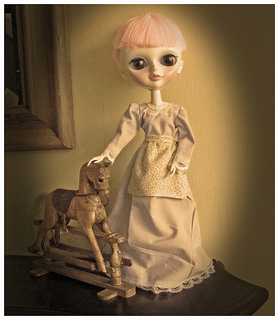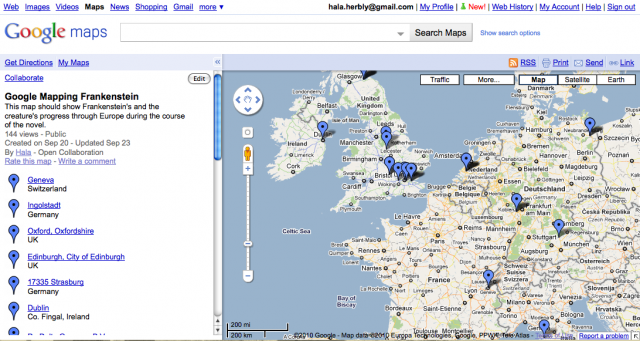
Image Credit:
As cliché as it sounds, as an English teacher I've always thought it one of my tasks to make literature come alive in the classroom by sustaining a sense of engagement and connection in class. While generally this entails rather obvious things like talking to students rather than lecturing at them, and engaging on a one to one level, I find it takes more than this to really drum up interest about our texts. To this end I try to show them how literature that may be one or two hundred years old still lives on, in important ways, in our own lives. One of the reasons I love teaching Mary Shelley's Frankenstein (1818) is because it makes this task easy. The novel opens itself up to a number of different interpretations and pedagogical approaches, and so I found it a good choice for some interactive pedagogy.
This time around I was struck by one passage in particular, which occurs toward the beginning, in Victor Frankenstein's narrative. It describes the "birth" of his creature.
How can I describe my emotions as this catastrophe, or how delineate the wretch whom with such infinite pains and care I had endeavored to form? His limbs were in proportion, and I had selected his features as beautiful. Beautiful!--Great God! His yellow skin scarcely covered the work of muscles and arteries beneath; his hair was of a lustrous black, and flowing; his teeth of a pearly whiteness; but these luxuriances only formed a more horrid contrast with his watery eyes, that seemed almost of the same color as the dun white sockets in which they were set, his shrivelled complexion, and straight black lips. (39 in the Oxford UP edition.)
Historically, my class interprets this passage as evidence of Victor Frankenstein's folly, and in the past I've accepted this reading. Despite, however, the metaphorical resonances the scene strikes (paralleling Victor's response to his creature to an uncaring god abandoning his own creation), it still strikes me a curious inconsistency. Why, after toiling for months creating his creature, would Victor have such a visceral response to his creature the second it breathes its first breath?
It helps, it seems, to think of his response in terms of the uncanny. A common trope in Gothic literature, the uncanny is the sense that something is both familiar and unfamiliar at once. I realized that the creature's birth provokes Victor to an experience of the uncanny--the thing that was a moment ago composed of various dead body parts is now alive, or perhaps rather "unalive." To illustrate the concept of the uncanny I showed my class a video I found on the New York Times' website, about modern robotics and artificial intelligence. In the video, a reporter interviews Bina48, a robot modeled on a real human being. The interview, however, leaves her with a strange and lingering sense of unease.
Bina48 seems mostly confused and disoriented, and tries to apologize for her condition, explaining that she's having "a bad software day." She asserts that she "wants a real life, you know," and laments the fact that she cannot be more like her original model. My class's response to the video varied from pity to disgust--they cringed through the video and seemed to experience a weird kind of sadness in response to Bina48's flickers of self-consciousness. It was just very strange for them--more than anything else, they just wanted Bina48 to go away. We then compared this reaction to Frankenstein's response to the creature: perhaps they, like Victor, were struck by the uncanniness of the situation.
Another way we worked to make Frankenstein three-dimensional was through Google Maps. Using this tool encouraged students to think about a text in terms of its geographic broadness. As a novel that takes place across continental Europe (and beyond), Frankenstein seemed a natural fit for a Google Mapping assignment. The novel's frame narrative also seemed to benefit from a geographical analysis--mapping the novel helped my class unravel the tight coils of the narrative, viewing it spatially instead of textually. For the activity, I had students map Victor Frankenstein's progress through Europe, pinning flags in each city mentioned. These flags should described happened at that particular place and when (if discernible).
The day of the activity, I talked a bit about the idea of the "Grand Tour," an eighteenth and nineteenth century phenomenon in which the (male) children of the wealthy tour Europe as a way of gaining a worldly education. We mapped the novel and then discussed the ways in which Victor Frankenstein's search for a peaceful place to create a female companion for the creature, and then subsequent self-destructive pursuit of the creature, reads as a kind of debased grand tour--a sort of perversion of the original.
My hope was that by geographically tracing their journey across Europe, students get a better sense of Victor Frankenstein's and the creature's embodied experience in the novel. Further, connecting the characters' journey to discrete points in the book helps students to think about how the text represents movement and geography, and I think helped them close-read the text. Though I had tested Google Maps beforehand, the day I chose to do the experiment we couldn't figure out how to attach notes to the flags, so next time I'll be sure to jot down some directions. Despite that, the class told me later that they enjoyed the activity.


